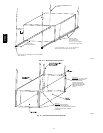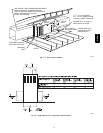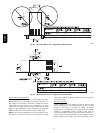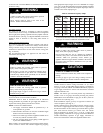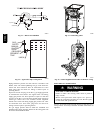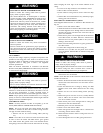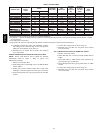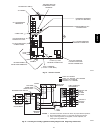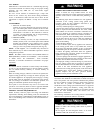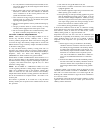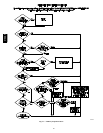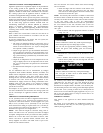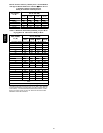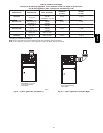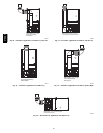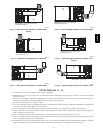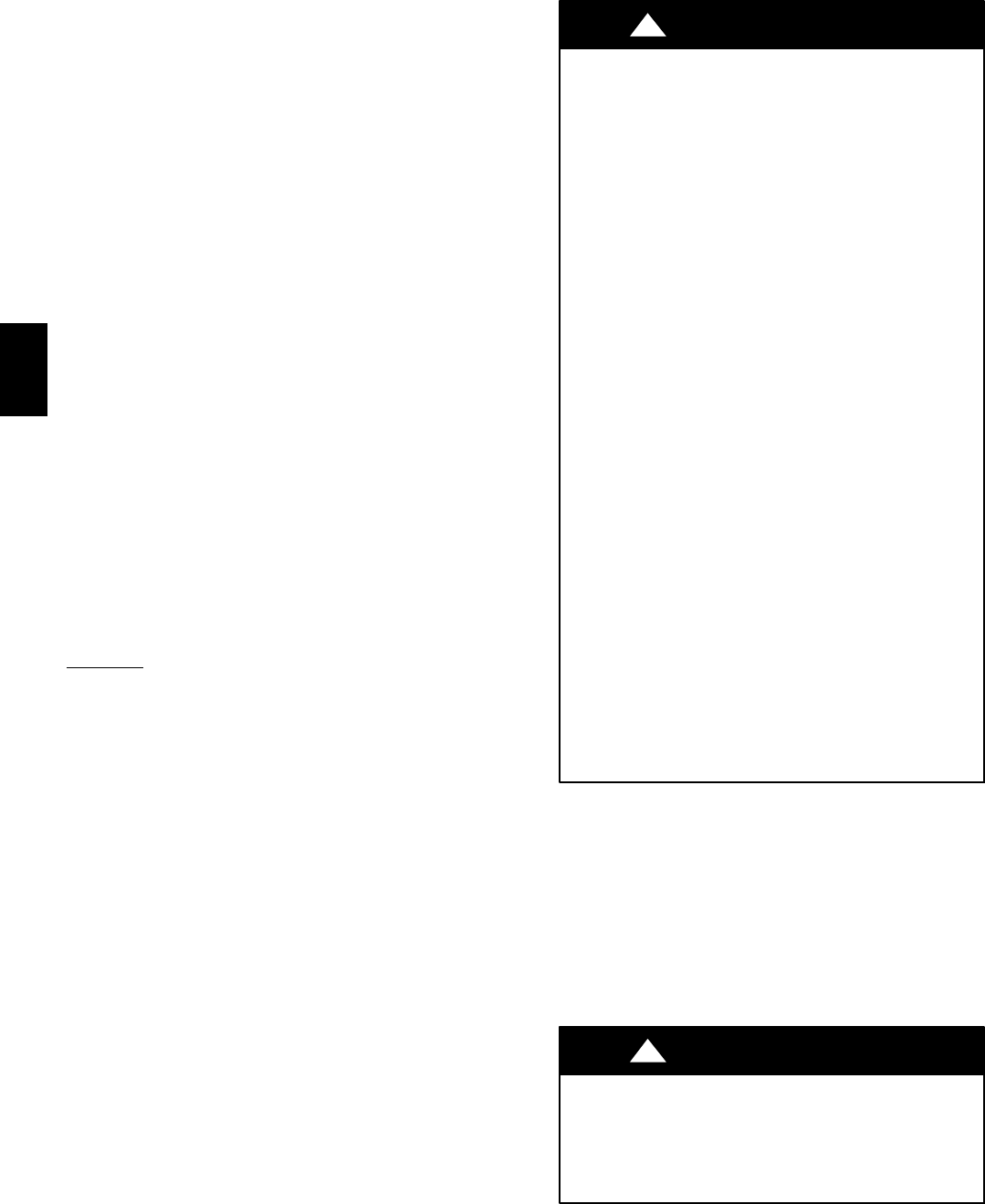
24
24--V WIRING
Make field 24--v connections at the 24--v terminal strip. (See Fig.
25.) Connect terminal Y as shown in Fig. 26 for proper cooling
operation. Use only AWG No. 18, color--coded, copper
thermostat wire.
The 24--v circuit contains an automotive--type, 3--amp. fuse
located on the control. Any direct shorts during installation,
service, or maintenance could cause this fuse to blow. If fuse
replacement is required, use ONLY a 3--amp. fuse of identical
size.
ACCESSORIES
1. Electronic Air Cleaner (EAC)
Connect an accessory Electronic Air Cleaner (if used) us-
ing 1/4--in female quick connect terminals to the two male
1/4--in quick--connect terminals on the control board
marked EAC--1 and EAC--2. The terminals are rated for
115 VAC, 1.0 amps maximum and are energized during
blower motor operation. (See Fig. 24.)
2. Humidifier (HUM)
Connect an accessory 24 VAC, 0.5 amp. maximum hu-
midifier (if used) to the 1/4--in male quick--connect HUM
terminal and COM--24V screw terminal on the control
board thermostat strip. The HUM terminal is energized
when gas valve relay (GVR) is energized. (See Fig. 24.)
NOTE: A field--supplied, 115--v controlled relay connected to
EAC terminals may be added if humidifier operation is desired
during blower operation.
NOTE: DO NOT connect furnace control HUM terminal to
HUM (humidifier) terminal on Thermidistatt, Zone Controller
or similar device. See Thermidistatt, Zone Controller,
thermostat, or controller manufacturer’s instructions for proper
connection.
VENTING
The furnace shall be connected to a listed factory built chimney
or vent, or a clay--tile lined masonry or concrete chimney. Venting
into an unlined masonry chimney or concrete chimney is
prohibited.
When an existing Category I furnace is removed or replaced, the
original venting system may no longer be sized to properly vent
the attached appliances. An improperly sized Category I venting
system could cause the formation of condensate in the furnace
and vent, leakage of condensate and combustion products, and
spillage of combustion products into the living space.
Vent system or vent connectors may need to be resized. Vent
systems or vent connectors, must be sized to approach minimum
size as determined using appropriate table found in the NFGC.
GENERAL VENTING REQUIREMENTS
Follow all safety codes for proper vent sizing and installation
requirements, including local building codes, the National Fuel
Gas Code ANSI Z223.1--2009/NFPA 54--2009 (NFGC), Parts 12
and 13, local building codes, and furnace and vent manufacturers’
instructions.
CARBON MONOXIDE POISONING HAZARD
Failure to follow the steps outlined below for each
appliance connected to the venting system being placed into
operation could result in carbon monoxide poisoning or
death.
The following steps shall be followed for each appliance
connected to the venting system being placed into
operation, while all other appliances connected to the
venting system are not in operation:
1. Seal any unused openings in venting system.
2. Inspect the venting system for proper size and horizontal
pitch, as required in the National Fuel Gas Code, ANSI
Z223.1/NFPA 54 and these instructions. Determine that
there is no blockage or restriction, leakage, corrosion and
other deficiencies, which could cause an unsafe condition.
3. As far as practical, close all building doors and windows
and all doors between the space in which the appliance(s)
connected to the venting system are located and other
spaces of the building.
4. Close fireplace dampers.
5. Turn on clothes dryers and any appliance not connected
to the venting system. Turn on any exhaust fans, such as
range hoods and bathroom exhausts, so they are operating
at maximum speed. Do not operate a summer exhaust fan.
6. Follow the lighting instructions. Place the appliance
being inspected into operation. Adjust the thermostat so
appliance is operating continuously.
7. Test for spillage from draft hood equipped appliances at
the draft hood relief opening after 5 minutes of main burner
operation. Use the flame of a match or candle.
8. If improper venting is observed during any of the above
tests, the venting system must be corrected in accordance
with the National Fuel Gas Code, ANSI Z223.1/NFPA 54 .
9. After it has been determined that each appliance
connected to the venting system properly vents when tested
as outlined above, return doors, windows, exhaust fans,
fireplace dampers and any other gas--fired burning
appliance to their previous conditions of use.
!
WARNING
These furnaces are design--certified as Category I furnaces in
accordance with ANSI Z21.47--2009/CSA 2.3--2009 and operate
with a non--positive vent static pressure to minimize the potential
for vent gas leakage. Category I furnaces operate with a flue loss
not less than 17 percent to minimize the potential for
condensation in the venting system. These furnaces are approved
for common venting and multistory venting with other fan
assisted or draft hood equipped appliances in accordance with the
NFGC, the local building codes, and furnace and vent
manufacturers’ instructions.
The following information and warning must be considered in
addition to the requirements defined in the NFGC.
CARBON MONOXIDE POISONING HAZARD
Failure to follow this warning could result in personal
injury or death.
Do not bypass the draft safeguard switch, as an unsafe
condition could exist which must be corrected.
!
WARNING
310AAV



